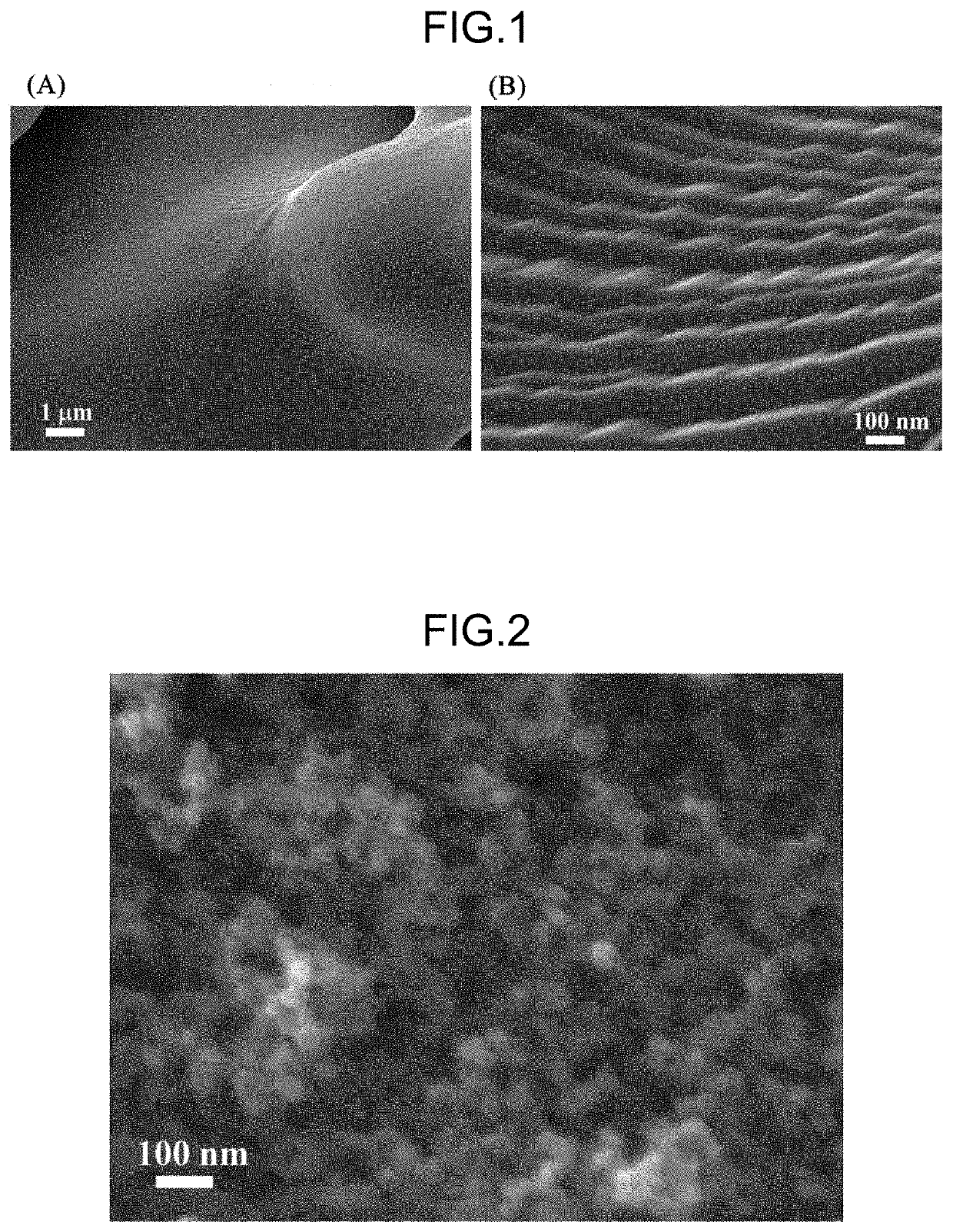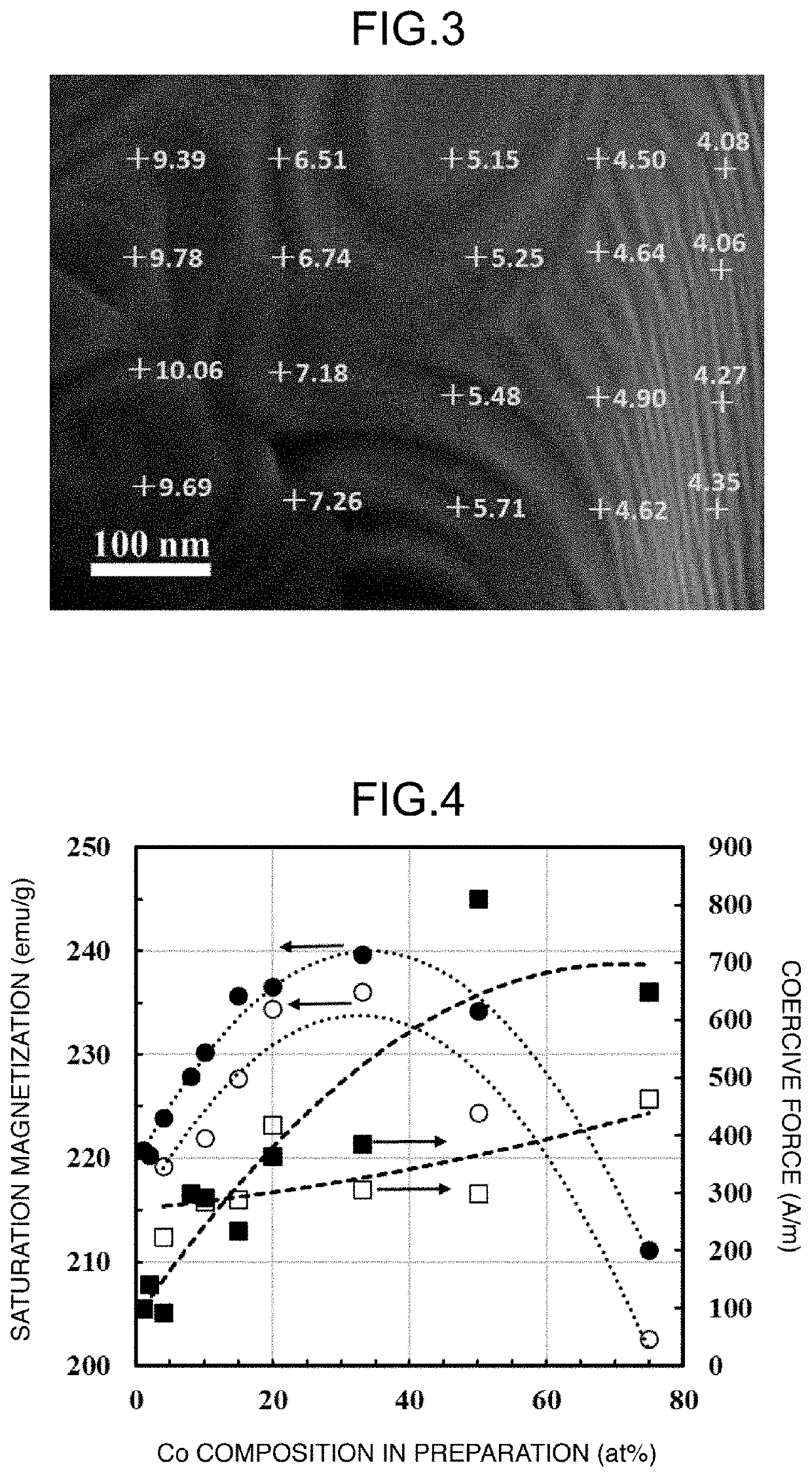Magnetic Material and Method for Producing Same
a technology of magnetic materials and materials, applied in the field of magnetic materials, can solve the problems of deterioration of magnetic properties, increased cost of punching and lamination steps, and increased cost of punching and lamination steps, and achieves high saturation magnetization, small eddy current loss, and high oxidation resistance.
- Summary
- Abstract
- Description
- Claims
- Application Information
AI Technical Summary
Benefits of technology
Problems solved by technology
Method used
Image
Examples
example 11
[0289]Aqueous solutions of MnCl2.4H2O (manganese(II) chloride tetrahydrate), an aqueous solution of CoCl2.6H2O (cobalt (II) chloride hexahydrate), and an aqueous solution of FeCl2.4H2O (iron (II) chloride tetrahydrate) were separately prepared, and a mixed aqueous solution of MnCl2, CoCl2, and FeCl2, obtained by mixing these solutions and adjusted to 50.3 mM, was placed in a reactor as a reaction field solution. It is noted that compositions of cobalt and manganese contained in the mixed aqueous solution, that is, the cobalt composition in preparation and the manganese composition in preparation were set to 4 atom % and 0.1 atom %, respectively. Next, a 660 mM aqueous potassium hydroxide solution (pH adjusting solution) was added dropwise while vigorously stirring in air, and the pH of the system gradually shifted from the acidic side to the alkaline side within a range of 4.69 or more and 9.32 or less. At the same time, a mixed aqueous solution of FeCl2 and CoCl2 of 168 mM was adde...
examples 12 to 17
[0295]A ferrite nanopowder was produced in the same manner as in Comparative Example 1 except that the Mn composition in preparation (the manganese composition in preparation) and the Co composition in preparation (the cobalt composition in preparation) were changed as described in Table 2, and the produced ferrite nanopowder was treated in the same manner as in Example 11 to produce a magnetic material powder. It was confirmed that the preparation amounts of Co agreed to the Co content obtained by XRF to the order of %.
[0296]The measurement results of the phases, the crystallite size, and the magnetic properties of these magnetic powders are shown in Table 2.
[0297]In FIG. 4, the measurement results of the saturation magnetization and the coercive force of Examples 1 to 17 are summarized with respect to the cobalt composition in preparation. In FIG. 4, ● and ▪ respectively represent values of the saturation magnetization (emu / g) and the coercive force (A / m) of the magnetic material ...
example 18
[0302]A magnetic powder of the present invention was obtained in the same manner as in Example 5 except that the reduction temperature was set to 550° C. It was found that the magnetic material of Example 18 was a semi-hard magnetic material of the present invention since a coercive force was 1670 A / m, which is a value more than 800 A / m and 40 kA / m or less. In addition, the saturation magnetization was 208.1 emu / g, which is an extremely high value among existing semi-hard magnetic materials, and the material had a good squareness ratio.
[0303]The measurement results of the phases, the crystallite size, and the magnetic properties of the magnetic powder of Example 18 are shown in Table 1. It was found that the Co-ferrite phase was slightly contained as the second phase by the XRD analysis.
[0304]It was confirmed that the crystallite size of the magnetic material of Example 18 reduced at 550° C. was about twice and the coercive force was 5.7 times as compared to the magnetic material of...
PUM
| Property | Measurement | Unit |
|---|---|---|
| volume fraction | aaaaa | aaaaa |
| average crystal grain size | aaaaa | aaaaa |
| average crystal grain size | aaaaa | aaaaa |
Abstract
Description
Claims
Application Information
 Login to View More
Login to View More - R&D
- Intellectual Property
- Life Sciences
- Materials
- Tech Scout
- Unparalleled Data Quality
- Higher Quality Content
- 60% Fewer Hallucinations
Browse by: Latest US Patents, China's latest patents, Technical Efficacy Thesaurus, Application Domain, Technology Topic, Popular Technical Reports.
© 2025 PatSnap. All rights reserved.Legal|Privacy policy|Modern Slavery Act Transparency Statement|Sitemap|About US| Contact US: help@patsnap.com


